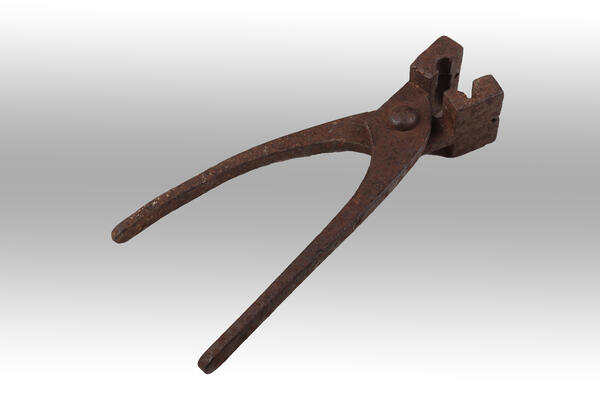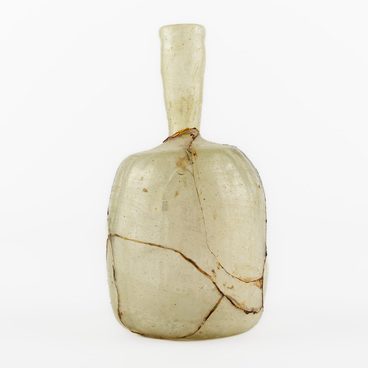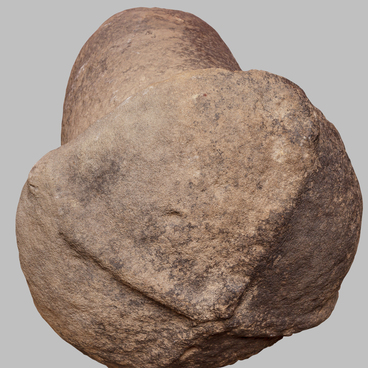A bullet mold is a tool for forming lead bullets. Since ancient times, lead has been used to make ammunition due to being cheap, widespread, readily available, resistant to moisture, and easily melted. Over a considerable time, the shape of the bullet has changed, and a device for replenishing ammunition has evolved. There were several types of bullet molds in terms of caliber, bullet shape and appearance. They could be designed for the casting of one or several bullets at once.
The bullet mold found in the Gelendzhik region looks like pincers, only with a cavity for pouring lead. This tool was used by the soldiers of the garrison in the Gelendzhik fortification. Specifically, this version of the bullet gun was used to make Minié balls for rifles. During the Caucasian War, Russian soldiers had to make their own bullets from the lead they were given.
At first glance, the process of casting a bullet seems simple: its essence boils down to the fact that molten lead was poured into a bullet-shaped cavity and cooled down, the bullet mold was opened, and the bullet was removed. However, in fact, everything was more complicated. Before starting work and pouring lead, the bullet mold had to be rubbed with chalk to prevent oxidation. The heating temperature of lead was determined approximately, which required some experience. Insufficiently heated lead did not completely fill the mold cavity and became layered. However, overheated lead led to surface oxidation and continued to boil inside the mold, so that cavities and voids appeared inside the bullet. The metal casting itself had to be homogeneous. If the timing was too short, the air did not have time to leave the cavity, while in the case of delay the lead solidified in layers, and the bullet turned out to be uneven. The bullet mold itself also had to be heated. For this, several test castings were made. The resulting bullets were carefully examined, their shape and color were checked. The casting process began only after a satisfactory result was achieved. Indeed, if the bullets had defects, accuracy and firing range deteriorated significantly.
A bullet mold was to be handled with care. It was allowed to clog its cavities with lead and small debris. It was strictly prohibited to clean bullet molds with emery or crushed brick. When the work was finished, the bullet mold was thoroughly wiped with a clean rag, and the metal parts were lubricated with a thin layer of low quality olive oil.
The bullet mold found in the Gelendzhik region looks like pincers, only with a cavity for pouring lead. This tool was used by the soldiers of the garrison in the Gelendzhik fortification. Specifically, this version of the bullet gun was used to make Minié balls for rifles. During the Caucasian War, Russian soldiers had to make their own bullets from the lead they were given.
At first glance, the process of casting a bullet seems simple: its essence boils down to the fact that molten lead was poured into a bullet-shaped cavity and cooled down, the bullet mold was opened, and the bullet was removed. However, in fact, everything was more complicated. Before starting work and pouring lead, the bullet mold had to be rubbed with chalk to prevent oxidation. The heating temperature of lead was determined approximately, which required some experience. Insufficiently heated lead did not completely fill the mold cavity and became layered. However, overheated lead led to surface oxidation and continued to boil inside the mold, so that cavities and voids appeared inside the bullet. The metal casting itself had to be homogeneous. If the timing was too short, the air did not have time to leave the cavity, while in the case of delay the lead solidified in layers, and the bullet turned out to be uneven. The bullet mold itself also had to be heated. For this, several test castings were made. The resulting bullets were carefully examined, their shape and color were checked. The casting process began only after a satisfactory result was achieved. Indeed, if the bullets had defects, accuracy and firing range deteriorated significantly.
A bullet mold was to be handled with care. It was allowed to clog its cavities with lead and small debris. It was strictly prohibited to clean bullet molds with emery or crushed brick. When the work was finished, the bullet mold was thoroughly wiped with a clean rag, and the metal parts were lubricated with a thin layer of low quality olive oil.



